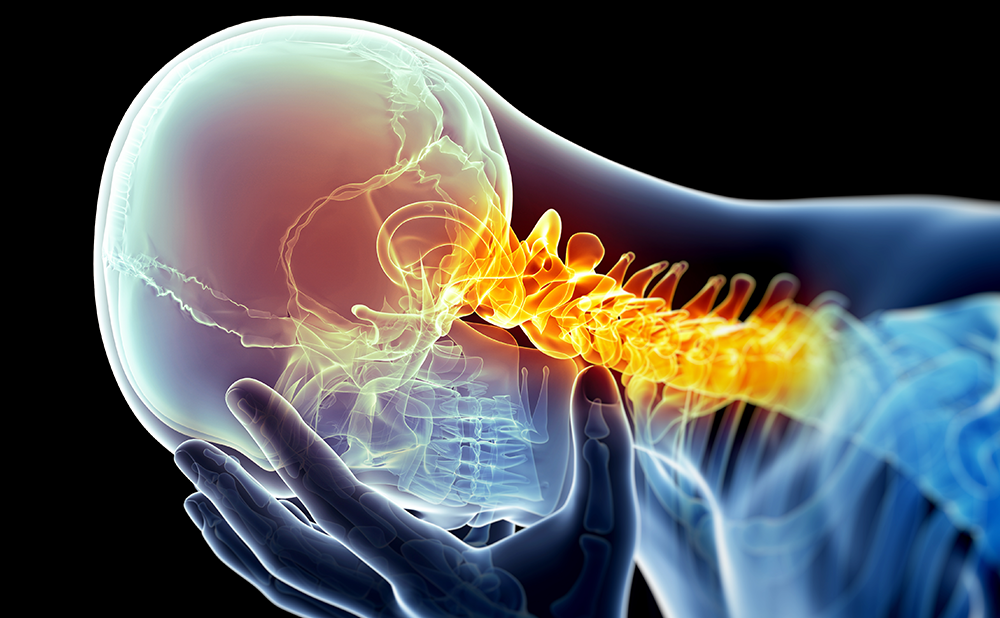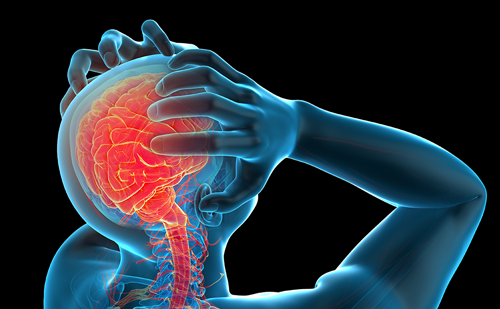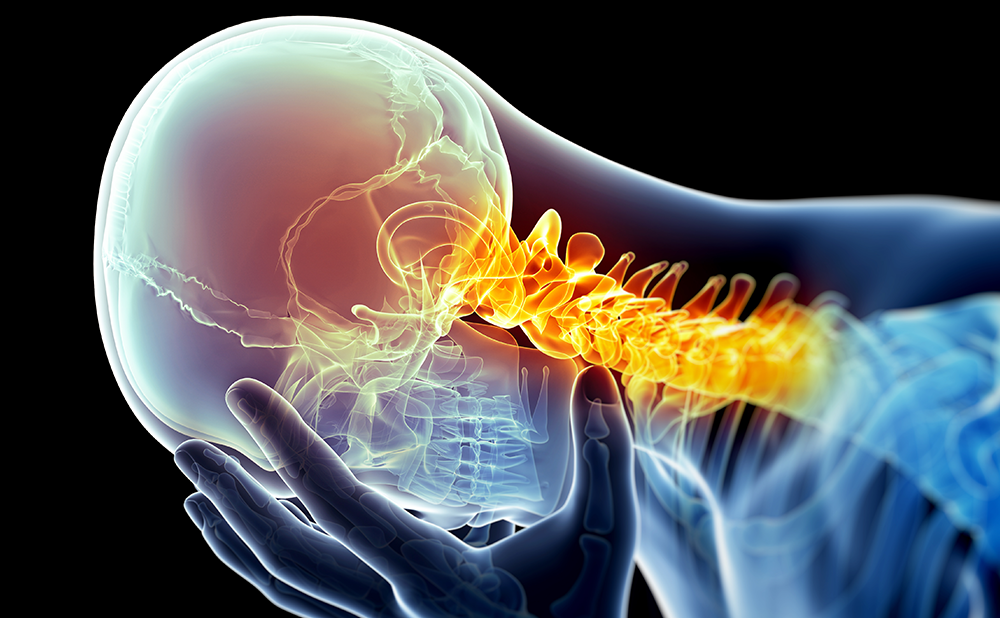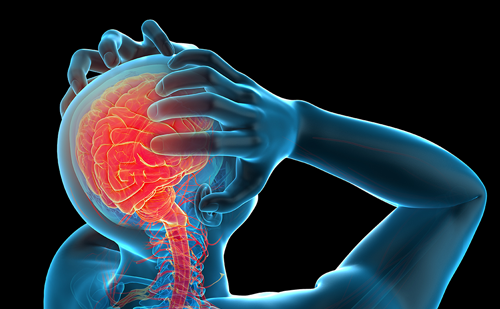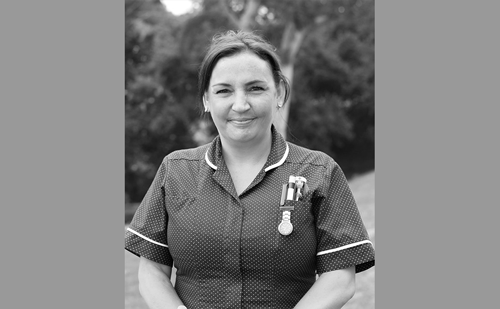Headache is the most common somatic complaint seen in the emergency department, accounting for 1 % to 3 % of all emergency department visits.1 Given the range of headache-related disorders, a systematic approach to headache classification and diagnosis is essential for best clinical management.2
Apart from the most common types of primary headaches (migraine, tension-type headache [TTH], cluster headache and other trigeminal autonomic headaches), Hippocrates was the first to mention the existence of others types of primary headaches. In 1932, Tinel described patients suffering from attacks of paroxysmal cephalalgia induced by exercise or activities that increased endothoracic pressure.3 In 1956, Symonds reported 27 patients suffering from transient headaches due to Valsalva manoeuvers (coughing, laughing, defecation, sudden postural movements).4 The author divided patients into two groups: the first included six cases with diagnosed intracranial injury; the other included the rest of the cases, where no injury was detected.4 Symonds first introduced the term ‘benign’ cough headache, without tissue injury.4 In 1968, Rooke described a large group of patients who suffered from exertional headache, where the rest of the primary headaches types were included (due to coughing, exercise and sexual activity).5 The following years more reports of similar cases were published.6–8
Other primary headaches form a heterogeneous group of fairly rare headaches characterised by paroxysmal transient pain that are not linked to tissue injury, according to the International Headache Society (IHS-1988).9 That term was changed in 2004,10 and nowadays, within the term ‘other primary headaches’ the new International Classification of Headache Disorders (ICHD-3 beta)11 includes: (1) headaches associated with physical exertion, including PCH, primary exercise headache (PEH), primary headache associated with sexual activity (PHASA) and primary thunderclap headache (PTH); (2) headaches attributed to direct physical stimuli, including cold-stimulus headache and external-pressure headache; (3) epicranial headaches including primary stabbing headache and nummular headache (NH); and (4) other miscellaneous primary headache disorders including hypnic headache (HH) and new daily persistent headache. In this review we highlight the recent knowledge and changes of the diagnostic criteria of other primary headaches.
Primary Headaches
Primary Stabbing Headache
Since 2004, primary stabbing headache (PSH) has replaced the previous terms (‘icepick-like pains’, ‘sharp short-lived head pains’, ‘needle-inthe- eye syndrome’ and ‘jabs and jolts syndrome’) being used broadly in the literature.12–15
PSH is characterised by transient and localised stabs of head–facial pain that occurs spontaneously in the absence of any organic disease of the underlying structures or the cranial nerves. It is difficult to estimate prevalence, but in various studies it ranges from 2 % to 35.2 % with a female to male ratio of 1.5/1 to 2.3/1.14–18
Rampello et al. reported that 13 of 26 patients who met the diagnostic criteria for PSH had a variety of associated autoimmune disorders (such as multiple sclerosis, systemic lupus erythematosus, Behçet’s disease, Sjögren’s disease), leading to speculation that autoimmune factors were the cause of PSH.19
PSH often co-exists with other types of headache, such as migraine, tension-type headache, cluster headache and chronic paroxysmal hemicranias.6-8,20 Although pathogenesis of PSH remains controversial, the paroxysmal manifestation of pain and its resemblance to trigeminal headache, suggests an intermittent deficit in central pain control mechanism that permits the spontaneous synchronous discharge of neurons receiving impulses from the area where stabbing pain is referred.16Furthermore, a combination of first trigeminal nerve pain area20 and migraine also suggests that the trigeminal vascular system might play a role in this headache disorder.21,22 According to the study of Fuh et al., 15 % of patients with PSH failed to fulfill the ICHDII criterion D ‘no accompanying symptoms’, due to accompanying phenomena such as jolts, vocalisation, allodynia, nausea, vomiting and photophobia/phonophobia.16New ICHD-3 beta criteria for PSH (see Table 1) specified that accompanying symptoms do not include cranial autonomic symptoms that differentiate PSH from shortlasting unilateral neuralgiform headache attacks.
Indomethacin is the medication of choice in doses of 25–100 mg per day.8,23,24 Alternatively, good response can be received with COX- 2 inhibitors, nifedipine, melatonin and gabapentin in patients with PSH.16,25–28 The chemical structure of melatonin (N-[2-(5-methoxy- 1H-indol-3-yl)ethyl] acetamide) is similar to that of indomethacin (2-{1-[(4-chlorophenyl)carbonyl]-5-methoxy-2-methyl-1H-indol-3-yl} acetic acid) with anti-nociceptive and anti-inflammatory properties in animal studies.26 It may explain its efficacy in patients with PSH.22
Primary Cough Headache
Formerly used terms: benign cough headache, Valsalva manoeuvre headache
Primary cough headache (PCH) was first described in 1956 by Symonds.4 This headache is precipitated by coughing or Valsalva manoeuver, but not by prolonged physical activity in the absence of any intracranial disorder.1,22 Pain attacks occur immediately after coughing, without accompanying symptoms such as nausea or sighs from the autonomic nervous system.22,29,30 PCH is usually bilateral, and affects mostly men (male/female = 4/1) older than 40 years old after a respiratory infection.1,31,32 The lifetime prevalence of PCH is about 1 %.14,31,32 Magnetic resonance imaging (MRI) findings revealed that 71.4 % patients with PCH showed at least one vascular abnormality (stenosis of the transverse sinus or of the jugular veins).32
Although the pathogenesis of PCH remains unknown, it has been noted that PCH, PEH and PHASA can be triggered by Valsalva-like manoeuvers, which may explain part of the pathogenesis. Pain is probably associated with deficits of the intracranial pressure control mechanism.22,33–35 It is believed that triggers such ascoughing, laughing, nose-blowing, bending or straining can elevate intra-abdominal and intrathoracic pressure, which is transmitted to epidural veins, causing spinal dura compression, with subsequent pressure increase in the spinal canal.
PCH is symptomatic in about 40 % of cases and the vast majority of these present Arnold-Chiari malformations type I.36 Because Arnold-Chiari malformation type I is the most common secondary cause of PCH, the lower prevalence of Arnold-Chiari malformation type I in Asians compared with Europeans (10.8 % versus 58.8 %) may account for this discrepancy.31,32 Neuroimaging plays an important role in differentiating secondary cough headache from PCH, especially to rule out a posterior fossa lesion.2
It is suggested that annual vaccination and usage of cough suppressants may prevent infections. Bending of the head and the torso after coughing can relieve symptoms. Indomethacin is effective (50–200 mg per day, and maintenance of dosage can last from 6 months up to 2 years). PCH may respond to acetazolamide (25–200 mg per day), methysergide (2 mg per day, for a total of 9 weeks) and intravenous dihydroergotamine.32,37If pharmacological treatment fails, lumbar puncture (spinal tap) should be an alternative.34
Primary Exercise Headache
Formerly used term: benign exertional headache
Hippocrates first described this type, encouraging his students “…to be able to recognise those who have headaches from gymnastic exercises, running or walking, or any seasonal labor…” PEH is a bilateral, shortlasting, pulsating headache.1,22 Most cases of PEH occur in migraineurs (46 % to 48 %).18,29,31,33
Divergent prevalence between 1 % and 30.4 % is reported among the general population.14,38,39 Large-scaled studies found a female predominance (54 % versus 44 % );18,38,39 although a significant male preponderance has been reported in previous hospital-based studies.31
ICHD II criterion A necessitates a “pulsating feature”, which could be observed in 87 % of PEH sufferers in the Vågå study,38 but only disclosed in 59 % of adolescent patients.18 However, it was rarely reported by patients in the Donnet et al. study (9.1 %).33 In addition, the duration of PEH was less than 5 minutes in 46 % of adolescent sufferers,18 making criterion B “lasting from 5 min to 48 h” less applicable, so it was removed from ICHD-3 beta criteria.
Pathophysiological mechanisms are unknown, although vascular origin has been proposed in venous or arterial distension secondary to physical exercise.29,31 Other causes of secondary exertional headache are: pheochromocytomas, chronic obstructive pulmonary disease, anabolic steroids and hypoplasia of the aortic arch after successful repair of coarctation.1,40 Onset of the patients’ typical headaches has been correlated with electrocardiobram (ECG) changes of myocardial ischaemia, suggesting that cardiological examination should be conducted in patients with PEH.40 We also have to exclude subarachnoid hemorrhage, arterial dissection and reversible cerebral vasoconstriction syndrome (RCVS).
PEH is more common in young patients aged 24±11 years old (in contrast to secondary exercise headaches that mostly occur in elder patients aged 42±14 years old), but is not associated with accompanying symptoms (vomiting, diplopia).41
Exercise headaches may be prevented by a warm-up period and good hydration.1 Excess body weight and excessive exercise, particularly in hot weather or at high altitude, should be avoided.1,39 Acetaminophen, non-steroidal anti-inflammatory drugs (NSAIDs) and indomethacin (25–150 mg per day), as preventative agents, can be of benefit if taken 1 hour before exercise.1,29 Prophylactic drugs used for migraine, such as beta-blockers, triptans, tartrate ergotamine and methysergide 1–2 mg may be effective for some patients (30 minutes before exercise).1,31
Primary Headache Associated with Sexual Activity
First described by Hippocrates, did not differentiate PHASA from exercise headaches. The first studies where PHASA was reported as a separate type of headache were in 1970 and 1976.42,43
PHASA is precipitated by sexual activity, usually starting as a dull bilateral ache as sexual excitement increases and suddenly becoming intense at orgasm, in the absence of any intracranial disorder.44 Two subforms (preorgasmic headache and orgasmic headache) were included in ICHD-I9 and ICHD-II,10 but clinical studies since then have found no significant differences in demographics, clinical features, comorbidities and prognosis, except for the mode of headache onset;45,46 therefore, in ICHD- 3 beta, PHASA is considered as single entity with variable presentation.
Two clinic-based studies reported that PHASA accounted for 1 % of all patients, with a rate ratio of men:women between 3:1 and 5:1.14,17,31,33,45,46 The mean age of onset is between the thirtieth and fiftieth years of life.31,33,45–47 Co-morbidity is common, such as migraine (19 % to 47 %), PEH (31 % to 40 %), tension-type headache, arterial hypertension and (less commonly) PCH.31,33,45,47 PHASA is occasionally accompanied by: nausea, phonophobia/photophobia, eye tearing and mood disturbance.31,33,45
The pathophysiology of PHASA is still unclear. Sexual headaches are not only precipitated during sexual intercourse or orgasm, can also occur during masturbation and nocturnal semen emission.48 Familial predisposition has been reported.49 It has been proposed that the transient increase of intracranial hypertension due to Valsalva manoeuver might be the underlying mechanism of sexual headache disorders.50 Venous abnormalities (stenosis of the transverse sinus or of the jugular veins) were detected in 12 out of 19 patients with PHASA.33 Tests with acetazolamide using stress Doppler sonography suggests impaired metabolic cerebrovascular auto-regulation.51 Several cases of orgasmic headache reported RCVS,47 but further investigation is required. Particular risk factors are described in association with sexual headaches: hypertension, obesity, poor physical health, psychosocial stress, migraine, exertional headache, family history of headache and cerebral occlusive arterial disease.50,52
Despite this, secondary causes of headaches are less common (7 % – 11 %) and must be excluded: subarachnoid haemorrhage (4.5 % to 12 %),53 arterial dissection, hydrocephalus due to Silvian aqueductal stenosis, obstruction of the lower aorta, spinal cord lesion and use of phosphodiesterase inhibitors.29,31,41,50,53,54 Patients with sexual headache should be evaluated with brain computed tomography (CT) and lumbar puncture, if they are seen shortly (up to 3 days) after the episode. Within this time even small subarachnoid bleeding may be detected.50 If vascular malformation is strongly suspected, a patient with sexual headache should undergo cerebral–spinal angiography to exclude a saccular aneurysm or arteriovenous malformation.31,50
Some authors suggest that remaining sexually inactive in an acute stage may be preventative,45 but stress management can be a more realistic solution. Calcium-channel blockers or 25–75 mg of indomethacin, 1 hour before sexual activity41,50 b-blockers, such as propranolol (40–200mg per day), showed also efficacy in prophylaxis.46,50 Topiramate (50 mg for 6 months) is used as prophylactic treatment against sexual headache, when b-blockers are contraindicated in patients with bronchial asthma.55
Hypnic Headache
Formerly used terms: hypnic headache syndrome, ‘alarm clock’ headache
HH is a rare primary headache disorder, which was first described by Raskin in 1988,56 and only 174 cases have been reported in the literature so far.57 As HH occur only during sleep, this fact potentially provides us with the most robust insight into the common aetiological mechanisms of headache and sleep.56,58,59 Evers and Goadsby suggested particular criteria for HH as one of the primary headaches unassociated with structural lesions.58
HH is a recurrent benign headache disorder that occurs exclusively during sleep and usually presents after age of 60 (prevalence: 0.07 % to 0.1 %).57–59 The majority of patients are women (male:female ratio varies from 1/1.2 to 1/1.7).57,58 HH attacks usually last from 15 minutes up to 6 hours which awaken the patient at a constant time each night being mild to moderate intensity.1,2,57–63
Pathophysiology of HH remains enigmatic. It has been suggested that HH might be a REM sleep disorder due to a disturbance of the sleeprelated physiology of brainstem structures, such as the dorsal raphe nucleus, the locus coeruleus and the periaqueductal gray matter.64,65 However, a frequent onset of headache attacks during REM sleep has also been reported for migraine (altered activity of the dorsal raphe nucleus before/during the episodes) and cluster headache (altered activity of anterior-lateral hypothalamic area during the attacks).59,61–63 This fact strengthens the hypothesis that hypothalamus is involved in the pathogenesis of primary headaches.61–63 The supra-chiasmatic nucleus of hypothalamus, the most important brain structure for endogenous circadian rhythm, has afferent and efferent connections with the periaqueductal gray matter.58,59 It has been proposed as the hypothesis of hypothalamic abnormality in HH.57 Structural imaging using voxel-based morphometry (VBM) showed a decrease of gray matter within the posterior hypothalamus.66,67 The exclusive relationship of HH with sleep, notably always during the same time of the night, and its tendency to occur in subjects older than 60 years imply: (i) a possible association with the changes of sleep physiology occurring in the elderly; (ii) an alteration of the function of the suprachiasmatic nuclei; and (iii) an impairment of melatonin secretion.59,68 Recent studies associated HH with non-REM sleep as well.69,70
Holle et al. re-evaluated the ICHD II criteria of HH.71Fifteen per cent of patients (three out of 20) contradicted the diagnostic criterion D “headache should not be accompanied by autonomic symptoms” because associated trigeminal autonomic signs were reported. Considering the few cases of HH reported in paediatric age,71 ICHD- 3 beta criteria11 (see Table 2) expand the age onset comapred with ICHD-II.10 Holle et al. reported that 70 % of patients also suffered from another type of headache, either migraine or tension-type headache.71 Due to its rarity, structural intracranial disorders and other headache disorders, such as short-lasting unilateral neuralgiform headache attacks with conjunctival injection and tearing (short-lasting unilateral neuralgiform headache attacks with conjunctival injection and tearing [SUNCT]) and obstructive sleep apnoea-related headache should be ruled out.72 Since hypertension may be a risk factor for triggering HH, Gil-Gouveia and Goadsby suggest that arterial blood pressure should be monitored for 24 hours, as a complementary diagnostic test.73
Controlled trials for the treatment of HH are lacking. Lithium is the most common successful treatment option in HH (grade C recommendation: 400 mg at bedtime),74 although it has been associated with serious side effects (sleepiness, tremor, thyroid and kidney impairment and worsening of headache).74 Lithium leads to an increase of serum melatonin level, which might be important in the pathophysiology of HH.74 Additionally, lithium causes down-regulation of serotonin receptors and an increase of serotonin release in the hypothalamus, by increasing brain tryptophan concentrations and serotonin synthesis from tryptophan.74 Bender reported a case where mandibular advancement oral appliance (MAD) therapy effectively treated a patient with HH.59 Another study reported a case where occipital nerve stimulation was effective in a patient with chronic, refractory HH.60 Lisotto et al. reviewed the efficacy of therapy used to treat HH; acute treatment is not recommended.75 Caffeine and lithium are the best prophylactic treatment choices; other medications can be used as second-line approach.71,75,76
Primary Thunderclap Headache
Formerly used term: Benign thunderclap headache
In 1986, Day and Raskin used the term ‘thunderclap headache’ (PTH) to describe the case of a 42-year-old patient who suffered from an intense sentinel headache of sudden onset. Patient evaluation was negative for subarachnoid haemorrhage, aneurysm or any other cause.77
PTH is a high-intensity headache that reaches a peak within seconds mimicking a ruptured cerebral aneurysm, but may persist for weeks.2,78,79 It is one of the common neurological presentations to the emergency department.79 New diagnostic criteria ICHD-3 beta can be seen in Table 3.
PTH is diagnosed when no specific aetiology is identified, despite a comprehensive diagnostic evaluation.78,79 The diagnosis of PTH can be established only after excluding severe vascular intracranial disorders, particularly subarachnoid haemorrhage.2,78,79 Differential diagnosis must include central nervous system (CNS) vasculitis, unruptured intracranial aneurysm, spontaneous intracranial hypotension, pituitary apoplexy, brain tumour (anaplastic or malignant oligodendroglioma) and Vogt–Koyanagi–Harada syndrome.79 Fortythree per cent of cases with subarachnoid haemorrhage have a history of PTH.80 Additionally, PTH can be the main symptom for 2 % to 13 % of patients with cerebral venous sinus thrombosis.80 Sudden-onset thunderclap headache has been reported as an unusual presentation of aortic dissection in two female patients aged 50 and 51 years old; aortic dissection should be considered as a potential cause of thunderclap headache.81,82 RCVS is characterised by reversible multifocal narrowing of the cerebral arteries heralded by thunderclap headaches with or without associated neurological deficits (neurological deficits are reversible in 10–12 % of cases).83 There are reports where it is stated that PTH is a unique presenting symptom of myocardial infarction.84,85 Rarely, cerebral infarcts have been presented with PTH alone.86–88
There is no evidence-based treatment for PTH. Lu et al. effectively treated 11 patients who suffered from PTH with oral nimodipine 30 mg to 60 mg every 4 hours (for 2–3 months) or intravenous nimodipine 0.5 mg/ hour to 2 mg/hour whenever the oral regimen failed.89 Drugs that cause vasospasm (such as triptans and ergotamine) should be avoided.
New Daily Persistent Headache
Formerly used terms: De novo chronic headache, chronic headache with acute onset
Vanast provided the first description of new daily persistent headache (NDPH) in 1986; most of his patients with NDPH suffered from accompanying migraine symptoms.90
NDPH is daily and unremitting from very soon after onset (within 3 days at most). The pain is typically bilateral, pressing or tightening in quality and of mild-to-moderate intensity. NDPH may be accompanied by photo/phonophobia or mild nausea with visual or olfactory aura.91,92
The prevalence of NDPH ranges from 0.03 % to 0.1 % according to population-based studies.93,94 NDPH is diagnosed in 1.7 % to 12 % of patients in tertiary headache clinics.95–97 NDPH is more common in females (female:male ratio 2.5/1).97–99 Overall, 18.4 % to 49.3 % of patients with NDPH reported a family history of tension-type headache and migraine.97,99,100
However, it has been suggested that ICHD-II criteria for NDPH were too restrictive; the main controversy is criterion D, regarding the presence of migrainous and tension-type headache features.98,99,101–104 ICHD-II acknowledges “no more than one of photophobia, phonophobia or mild nausea” in NDPH. Some authors proposed a revised version of ICHD-II criteria, creating a NDPH-ICHD subgroup (referring to patients meeting ICHD-II criteria) and a NDPH- ICHD subgroup (referring to those cases with too many migraine-type features). Only 43.7 % of cases with NDPH met all the ICHD-II criteria (NDPH-ICHD subgroup).98,102–105 Bigal et al. concluded that headaches with migraine features of new and persistent onset are often classified as NDPH, which do not meet the ICHD-II criteria.95,96 New ICHD-3 beta overcomes these limitations, even though the criteria for chronic migraine and/or chronic tension-type headache may also be fulfilled, the default diagnosis is NDPH whenever the criteria for this disorder are met (Table 4).11
However, NDPH distinguishes itself from chronic tension-type headache by its continuous headache from onset, lacking the gradual evolution of a preexisting episodic headache.106 Headache onset is often so striking that most patients (33–82 % of cases) are able to recall, if they cannot do so another diagnosis should be made.97–99 Triggering factors for NDPH include: stress, flu-like infections (50 % in children; 30 % in elderly), upper respiratory infections, extracranial surgery, injury, Epstein–Barr virus (EBV) infection (84 % patients with NDPH, compared with 25 % of control group), cytomegalovirus (CMV) infection and herpes simplex virus (HSV) infection.97–99,107–111
NDPH should be differentiated from secondary headaches such as medication overuse headache, (post-viral and post-bacterial) meningitis, sphenoid sinusitis, neoplasms, chronic subdural haematoma, post-traumatic headaches, post-infectious headache (mostly viral), hypertension, spontaneous intracranial hypotension, pseudotumor cerebri, cervical artery dissection, cerebral venous thrombosis, arteriovenous malformation, dural arteriovenous fistula, unruptured intracranial saccular aneurysm, Arnold-Chiari malformation, giant cell arteritis, temporo-mandibular joint dysfunction and RCVS.107–108
In absence of guidelines for NDPH management, treatment becomes difficult, based on previous therapeutic experience of other chronic daily headaches.98 The most preferred regimen is a combination of steroid (methylprednisolone) + sodium valproate + antidepressant (amitriptyline or dothiepin) ± naproxen.98,107 Prophylaxis seems to reduce olfactory aura.112 Other commonly used treatments include: nortriptyline, topiramate, propranolol, levetiracetam, valproic acid, clonazepam, selective serotonin reuptake inhibitors, muscle relaxants and botulinum toxin type A.98,99,107,113
New Entries to International Classification of Headache Disorders-3 Beta
A growing body of evidence indicates that NH is a primary headache disorder, and therefore it has been moved from the appendix of ICHDII to the ICHD-3 beta. Cold-stimulus headache and external-pressure headache originally in chapter 13 of ICHD-II10 have also been moved to new ICHD-3 beta.11 The latter headaches include external-compression headache and the newly added entity, external-traction headache, because these seem more likely to be primary headache disorders in that they are brought on by physiological (non-damaging) stimuli.
Nummular Headache
Previously used term: coin-shaped headache
NH is a newly chronic, categorised headache disorder11 (ICHD-3 beta criteria are shown in Table 5) characterised by rounded or elliptical shape of mild-to-moderate painful area in the absence of any underlying structural lesion.114 The symptomatic area may be localised in any part of the head but mostly in the parietal region. During and between symptomatic periods, the affected area may show variable combinations of hypoesthesia, dysesthesia, paresthesia, tenderness and trophic changes. NH must be distinguished from head pain secondary to local disorders and from tender points of more extensive headaches.
In contrast to suggestion of peripheral neuralgia in NH, a few intracranial disorders, such as meningioma or arachnoidal cyst, have been found in patients presenting with a typical course of NH. Even though over 200 cases have been reported so far, there have been no prospective placebo control trials for treatment. Observational data suggested botulinum toxin type A (BoNTA), NSAIDs, tricyclic antidepressants and gabapentin may be beneficial.115
Cold-stimulus Headache
Cold-stimulus headache is a short-lasting frontal or temporal bilateral and throbbing headache following exposure to very low environmental temperature.11,116–118 Its subforms are ‘Headache probably attributed to external application of a cold stimulus’ and ‘Headache probably attributed to ingestion or inhalation of a cold stimulus’.116,117 It seems that ‘cold-stimulus headache’ was significantly higher in males than in females, and increased with grade.117 Students with migraine had a higher frequency of ice-cream headache compared with the students without migraine (55.2 % versus 39.6 %; p<0.0001).117 The prevalence of ice-cream headache increased among students with more migrainous features.117 As a newly classified disorder there is lack of evidence for pathophysiology and treatment. New ICHD-3 beta criteria11 are shown in Tables 6 and 7.
External-pressure Headache
External-pressure headache results from sustained compression of or traction on pericranial soft tissues without damage to the scalp. The wearing of bands around the head, specifically goggles (such as those worn for swimming), tight hats or even professional helmets have been described as causative factors.11 In a retrospective study by Krymchantowski among 82 police officers from Rio de Janeiro119 patients (13.4 % of the total; 30.5 % of those with migraine) complained of headache associated with wearing a helmet.119 External-traction headache (previously used term Ponytail) occurs only during traction on scalp. In both cases, headache relief needs only pressure removal.120 Diagnostic criteria are summarised in both Tables 8 and 9.
Prognosis In general, prognosis for other primary headaches is good, when secondary causes have been excluded. Other primary headaches usually subside within 6 to 24 months; some may be relapsing after prolonged remission. Whether responsive to indomethacin or not, PCH usually subsides within 6 months to 2 years, and recurrence is uncommon.32 PSH is rare and self-limiting,19 so its prognosis is good, supposing that no underling secondary cause exists.
Patients with PEH usually experience pain for a short period, however, long period of 30 years has been reported.15 Rooke followed 103 patients with benign exertional headache and no detectable intracranial disease on initial examination was noted.5 After almost 3 years of follow-up, 10 patients subsequently developed organic intracranial lesions suggesting that long-term follow-up is needed.5
About 33–50 % of patients with PHASA have relapsing or chronic course lasting almost 1 year; however, 69 % of those with a chronic course finally obtain remission at a longer follow-up.46,47
Nevertheless, thunderclap headaches usually subside within a few days or weeks with or without therapy.1 NDPH can be difficult to treat, especially the medication-resistant subtype.107 In Vanast’s initial description, 86 % of men and 73 % of women were headache-free within 2 years of headache onset.90 However, Robbins et al. have shown that NDPH is more refractory to treatment with poor prognosis.99 According to recent studies, there are two groups of patients with HH: a chronic-unremitting group (which includes most of the cases) and a relapsing-remitting variety.98
Conclusions
ICHD-II was insufficient for assessing headache diagnosis, so new headache classification was indispensable for research and daily practice. ICDH-3 beta provides a dynamic and clinically useful instrument, broadening our understanding of this rare group of other primary headaches. New revised 2013 (ICHD-3 beta) criteria have been proposed, including new types of other primary headaches, resolving all cases where ICDH-II classification was too restricted, incomplete or unclear. If headache disorder is atypical or difficult to classify, the possibility of secondary headache should be kept in mind and treatment modification should be reconsidered. In contrast to previous classifications, new ICHD-3 beta provides a vehicle for much-needed further study of pathophysiological mechanisms for early diagnosis and adequate treatment of headaches. Consequently, laboratory and genetic tests will be more compelling.


